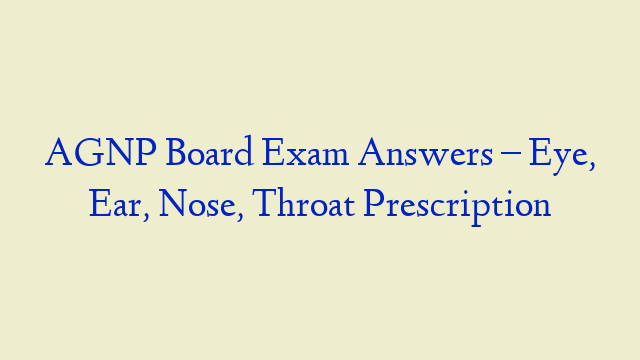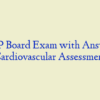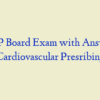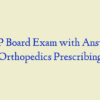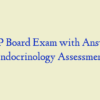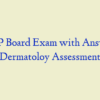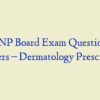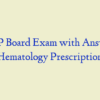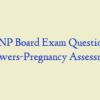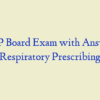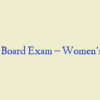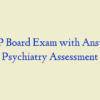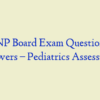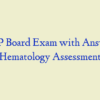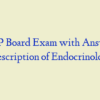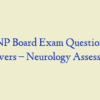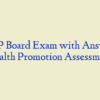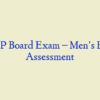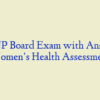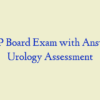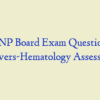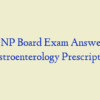Description
AGNP BOARD EXAM QUESTIONS EYE EAR NOSE THROAT Prescription (102 Questions)
- Oral tetracycline (Sumycin), for the treatment of acute frontal sinusitis, should be administer:
- The brand name for sulfacetamide ophthalmic is:
- The generic name for Polytrim ophthalmic is:
- Which of the follow does NOT cause a drug-disease interaction when use a decongestant/antihistamine medication such as Naphazoline/pheniramine (Naphcon-A)?
- The maximum daily dose of acetaminophen for ages 12 years and older is:
- For treatment of blepharitis, patients should be instruct to apply erythromycin ointment to the affected eye using:
- Ophthalmic cromolyn inhibits the degranulation of sensitized mast cells. It is indicated in the treatment of:
- The most effective treatment for eradication of group A streptococcus in those who are apparent carriers is:
- The generic name for Dramamine is:
- For empiric treatment of patients with acute bacterial rhinosinusitis (ABRS) who are allergic to penicillin, the best alternative first-line therapy is:
- Dosing of oseltamivir (Tamiflu) for adults and adolescents with active influenza is administered orally:
- The vasoconstrictive properties of alpha-1 agonist medications make them beneficial for the treatment of:
- The use of oral acyclovir (Zovirax) in older adults is more likely to cause:
- Cephalosporins are classified as:
- The onset of action of oxymetazoline (Afrin) is:
- Erythromycin (Ilotycin) ophthalmic ointment is classified as a(n):
- A common side effect of amoxicillin in children is:
- The first-line antibiotic for acute otitis media in a child with a potential for beta-lactam resistance is:
- The ophthalmic preparation that is NOT available over the counter is:
- Refractory blepharitis is best treated with:
- A serious adverse reaction to clindamycin (Cleocin) is:
- Which of the following is NOT a potential adverse effect of sulfacetamide ophthalmic (Bleph-10) for the treatment of acute conjunctivitis?
- The preferred class of oral antibiotic therapy for blepharitis with visual impairment is:
- Ocular steroids indicated for the treatment of allergic conjunctivitis can be used in patients with:
- The brand name for meclizine is:
- Oxymetazoline nasal spray, a nasal decongestant, is manufactured under the brand name:
- The most effective method to minimize dizziness associate with the administration of otic solutions is to:
- Intranasal antihistamines are indicate in the treatment of:
- Due to potential drug-drug interactions, therapy should be monitor when a patient is receiving erythromycin (Eyemycin) ointment and:
- When prescribing polymyxin B sulfate/bacitracin zinc (Polycin-B), patients should be instruct to:
- Ceruminolytics are safe to use in patients with history of:
- Polymyxin B/trimethoprim ophthalmic is NOT indicated for:
- A common side effect of azelastine (Optivar) ophthalmic drops used for allergic conjunctivitis is:
- If ocular steroids are to be used for more than 10 days, monitoring should include:
- Oxymetazoline (Visine-LR) is an ophthalmic:
- Potential adverse reactions of glucocorticoid nasal sprays do NOT include:
- The mechanism of action of trifluridine (Viroptic), an ophthalmic antiviral, used in the treatment of herpes simplex conjunctivitis is:
- After the administration of olopatadine (Pataday) ophthalmic for allergic conjunctivitis, contact lenses should not be inserted for at least:
- The duration of action of meclizine (Antivert) is:
- A common side effect of oral phenylephrine (Sudafed), a decongestant, is:
- Polycin-B is the brand name for:
- Naphazoline/pheniramine (Naphcon-A) is indicate in the treatment of:
- An example of a drug that is a cholinergic agonist is:
- Bacitracin (Ocu-Tracin) ophthalmic ointment inhibits bacterial cell wall synthesis by:
- Which risk factor would NOT prohibit the nurse practitioner from prescribing prednisolone acetate (Pred Forte)?
- The duration of action of ocular decongestants such as oxymetazoline (Visine-LR) is approximately:
- Systemic absorption of ocular decongestants, such naphazoline (Naphcon) may cause:
- A common side effect relate to the administration of cetirizine (Zyrtec) is:
- Patients being treat with trifluridine (Viroptic) for herpes simplex 1 keratoconjunctivitis should be advised to return to the clinic if they do not experience symptom improvement within:
- Which of the follow organisms is NOT susceptible to sulfacetamide ophthalmic (Bleph-10)?
- Which patient should be closely monitor for systemic effects of prolonged ocular steroid therapy?
- Penicillins are primarily prescribe for the treatment of infections cause by:
- The mechanism of action for mast cell stabilizers is:
- For patients who anticipate exposure to a specific know eye allergen, such as pollen, the best preventive therapy is a topical ophthalmic:
- Tetracyclines should be avoided in patients who are allergic to:
- The standard concentration of acetaminophen liquid for pediatric use is:
- Second-generation antihistamines:
- Long-term or repeated use of polymyxin B/trimethoprim ophthalmic drops may cause:
- After instilling ophthalmic drops, patients should be instruct to hold pressure to the medial punctum and nasolacrimal sac. The purpose of this is to:
- The mechanism of action for macrolides is to:
- The mechanism of action for meclizine (Antivert) is to:
- Brand names of sulfamethoxazole/trimethoprim do NOT include:
- Dosing of oseltamivir (Tamiflu) for older adult patients with active influenza and a creatinine clearance between 30-60 mL/min is:
- The mechanism of action of pheniramine is that it:
- Which of the follow is a cholinergic agonist use in the treatment of glaucoma?
- The correct method for instilling ophthalmic ointments is to:
- Erythromycin (Ilotycin) ophthalmic ointment is NOT indicate in the treatment of:
- A patient is receiving amoxicillin (Amoxil) for the treatment of otitis media. A hypersensitivity reaction would present with symptoms of:
- An alternative treatment for a child who has Strep throat and who has had a Type I hypersensitivity reaction to penicillin is:
- Patients should be advise to administer polymyxin B/trimethoprim every:
- Penicillins are primarily prescribe for the treatment of infections cause by:
- First-line treatment for children who are diagnose with Strep pharyngitis is:
- The most common symptoms of penicillin allergy include hives, itchy eyes, and:
- Patients and caregivers should be advise to stop oseltamivir (Tamiflu) and notify the provider immediately if the patient develops:
- Azelastine (Astelin), for treatment of allergic rhinitis, is classified as a nasal:
- A benefit of prescribing an ophthalmic antihistamine with a mast cell stabilizer property would be that the mast cell stabilizer provide:
- The best topical antibiotic choice for the treatment of acute blepharitis is:
- Ocular decongestants such as oxymetazoline (Visine-LR) are use to reduce:
- The mechanism of action of polymyxin B/trimethoprim ophthalmic is:
- Patients who are use a glucocorticoid nasal spray should be advise to:
- When a patient must administer more than one ophthalmic medication, they should be instructed to administer the drops:
- Which of the follow is classified as a second-generation antihistamine?
- A patient is diagnose with group A Streptococcus pharyngitis. The best choice for antimicrobial therapy is a:
- The brand name for cetirizine is:
- Sulfacetamide/prednisolone (Blephamide) is NOT indicate in:
- Prolonged use of bacitracin ophthalmic may result in:
- The most effective treatment for allergic rhinitis is:
- The generic name of Pataday ophthalmic drops used in the treatment of allergic conjunctivitis is:
- A medication that acts on the hypothalamus to produce antipyresis is:
- The appropriate duration of oral penicillin for a patient who has been diagnosed with group A Streptococcus pharyngitis is:
- The most effective treatment for eradication of group A streptococcus in those who are carriers is:
- The generic name for Restasis is:
- The generic name for AzaSite ophthalmic drops is:
- Which of the following is NOT a mechanism of action of ocular steroids?
- Due to the potential development of pseudo tumor cerebri, tetracycline (Sumycin) should not be administered concomitantly with:
- The most important caution when prescribing aminoglycosides for treatment of otitis externa is:
- The duration of action of azelastine (Optivar) ophthalmic drops is:
- A 38-year-old man has been receiving oral tetracycline for the treatment of refractory blepharitis. The patient should be refer to ophthalmology if experience:
- The brand name of prednisolone acetate ophthalmic is:
- Which of the following is NOT an antihistamine?
- The LEAST concerning side effect of first-generation antihistamines (i.e., dimenhydrinate) in patients older than 65 for the treatment of vertigo is:
- Check out our latest courses on PSYC 502 Week 3.
